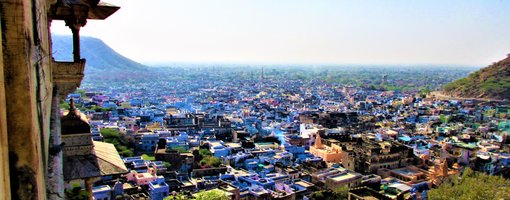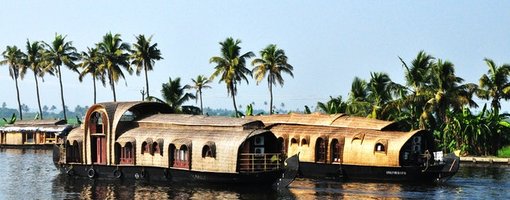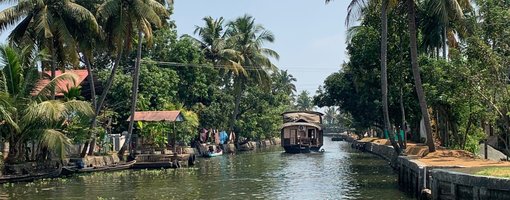Every now and again we come across a place that we fall in love with a little. For us, Hampi, in the Indian state of Karnataka, was one of those places. Magical and bewitching, Hampi is an ancient temple town surrounded by 16th century ruins. Giant boulders are strewn across the landscape, set against a backdrop of vibrant green paddy fields and palm trees.

The View from Matanga Hill
Enchanted by Hampi
We arrived in town after a twelve hour overnight bus journey from Panaji. Weary from the bone-shaking journey on pot-holed roads, we pushed our way through the sea of insistent touts and headed to the bazaar. Breakfast was first on the agenda.
The sights and sounds of the bazaar were immediately engaging. Cows wandered the narrow streets, children played amongst the colourful buildings and women gathered in groups drinking chai. We passed Virupaksha, the stunning Hindu temple dedicated to Vishnu and Shiva, and centre piece of the town. Monkeys leapt from pillar to post and a dreadlocked sadhu sat at the ornate entrance. We were already enchanted by Hampi.

Colourful Temple Topts
Crossing the River
After breakfast, we walked to the Tungabhadra River, where we discovered Lakshmi, the temple elephant having her morning bath. We took a taxi boat across the river with a jolly looking sadhu, and then strolled down a track surrounded by fields to The Shanthi Guest House, which we had pre-booked. By comparison to the buzz of Hampi, this side of the river felt rural and peaceful.
Our thatched bungalow overlooked a rice paddy, beyond which water buffalo grazed. We even had a hammock on the porch, a perfect spot to chill out and reconnect to the sights and sounds of nature.

Crossing the River
Exploring the Sights of Hampi
Over the next few days, we explored Hampi in depth. Walking for miles in the intense heat under deep blue skies, we stumbled across stunning ancient ruins and beautiful natural phenomenon. Deservedly adorned with UNESCO World Heritage status, Hampi and its surrounding area formed part of the fourteenth century Vijayanagara Empire.

Balancing Boulders
Some of the buildings, such as the Royal Elephant stables were in relatively good condition, whilst others were crumbling and neglected, but were equally fascinating and atmospheric.
A Landscape of Rocks and Boulders
Refreshingly devoid of crowds, except in the more well-known areas, we wandered freely amongst the ruins and boulders. Some of the huge rocks were precariously balanced on top of one another forming extraordinary looking sights reminiscent of the desert landscapes of the western USA.

Monuments and Boulders Galore!
Making New Friends
Occasionally, as is often the case in India, we were approached by Indian tourists who wanted to practise English or have a photograph taken with us. Some were just inquisitive, rarely having encountered westerners, and others simply wanted to chat.
Matanga Hill
One of our favourite spots was Matanga Hill, which provides sublime views of Hampi and beyond. We spent hours up there, sitting and taking in the magnificence of the otherworldly landscape. Without doubt, it was one of the most the spiritual and uplifting sights we have ever seen. We wanted to ensure that it would be etched in our memories forever.

From the Hilltop
Hippie Restaurants
An abundance of hippie style restaurants, complete with low tables and scatter cushions provided an occasional welcome retreat from the scorching sun. After a rest and a fresh mango lassi, we were ready to continue our explorations.
As the sun went down, we ate delicious thalis in one of the many rooftop restaurants. Being a temple town of great spiritual significance to Hindus, alcohol is banned. We heard, however, that it is not impossible to obtain illicit beer from some of the restaurant owners. Additionally, only vegetarian food is served within the confines of the town. It's not a bad idea to eat mainly veggie food in India anyway, as it significantly cuts the chances of suffering from Delhi Belly!
Most of the restaurants and cafes in Hampi don't have websites. Two of the best are Hampi Roof Restaurant and Sagar Hotel. An all women initiative, Sagar Hotel serves delicious South Indian breakfasts.
Pro Tip:
Stick to eating Indian food in Hampi if possible. Ku made the mistake of ordering a ‘Maxican' burrito and severely suffered the consequences! T only ate Indian food, which not only tasted better, but didn't have any adverse effects.

Monkey Business!
Accommodation
Accommodation in Hampi is generally basic. The majority of accommodation consists of small guest houses. There are no Best Westerns in town, and it is all the better for it. You can either choose to stay in the area of the bustling bazaar or on the other side of the river in mellow Tungabhadra. There are a few slightly more upmarket hotels in the town of Hospet, which is about seven miles away from Hampi.
We stayed at The Shanthi Guest House on the other side of the river for a night when we arrived. It's a very tranquil and beautiful spot set amongst the paddy fields. Apart from a dispute with a manager, who insisted that we hadn't paid (which we had!) we enjoyed our stay there. There was also a restaurant on a terrace overlooking the fields. We then moved to a guest house in the bazaar for a few nights.

Carvings at the Elephant Stables
If you are seeking peace and quiet, it's probably best to cross the river. Those who do venture across have to return early though – the last boat of the day making the three minute crossing leaves at 6.00 pm.











